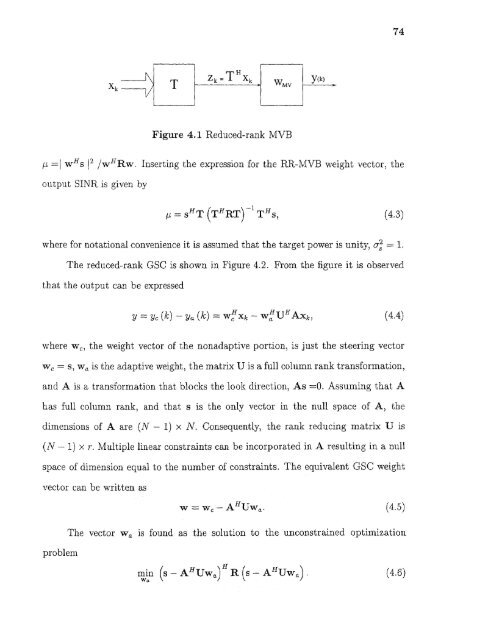Space/time/frequency methods in adaptive radar - New Jersey ...
Space/time/frequency methods in adaptive radar - New Jersey ...
Space/time/frequency methods in adaptive radar - New Jersey ...
Create successful ePaper yourself
Turn your PDF publications into a flip-book with our unique Google optimized e-Paper software.
74Figure 4.1 Reduced-rank MVBoutput SINR is given by<strong>in</strong>sert<strong>in</strong>g the expression for the RR-MVB weight vector, thewhere for notational convenience it is assumed that the target power is unity, σs² = 1.The reduced-rank GSC is shown <strong>in</strong> Figure 4.2. From the figure it is observedthat the output can be expressedwhere w c , the weight vector of the non<strong>adaptive</strong> portion, is just the steer<strong>in</strong>g vectorw, = S, Wa is the <strong>adaptive</strong> weight, the matrix U is a full column rank transformation,and A is a transformation that blocks the look direction, As =0. Assum<strong>in</strong>g that Ahas full column rank, and that s is the only vector <strong>in</strong> the null space of A, thedimensions of A are (N — 1) x N. Consequently, the rank reduc<strong>in</strong>g matrix U is(N — 1) x r. Multiple l<strong>in</strong>ear constra<strong>in</strong>ts can be <strong>in</strong>corporated <strong>in</strong> A result<strong>in</strong>g <strong>in</strong> a nullspace of dimension equal to the number of constra<strong>in</strong>ts. The equivalent GSC weightvector can be written asproblemThe vector w a, is found as the solution to the unconstra<strong>in</strong>ed optimization
















